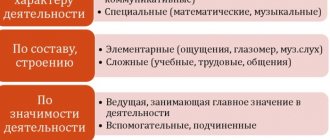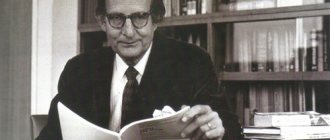About the concepts of introversion and extraversion
Dichonomic concepts in Personality Theory define people's attitudes according to their inclinations to evaluate internal sensations or external events. A person is endowed with a certain set of qualities at birth. Typological affiliation is the basis for the entire period of personality formation.
What is extraversion
Extraversion is a personality’s focus on relationships with the outside world. An extrovert may have a rich inner world, but he can only demonstrate his abilities in interaction with the surrounding society.
Extroverts do not tend to take a long time to understand their feelings; they quickly navigate the situation. People of this psychotype do not hesitate to make decisions, but are capable of radically changing their attitudes under the influence of the environment.
What is introversion
Introversion in psychology is a number of personal characteristics of an individual that are aimed at avoiding social contacts. A person with this orientation is focused on the mental activity of his inner self. The accumulation of energy during introversion occurs inside a person.
Introversion is the ability to control your feelings and plan your actions. Introverts take a long time to make decisions, but for them they become the only and unshakable ones.
What is extraversion
The term “extroversion” comes from the Latin extra and vert - turned or turned outward .
In a broad sense, “extroversion” means an individual’s focus on the outside world. This is reflected in a person’s lifestyle - a tireless desire to be among people, to gain new information and ideas, to be in the center of events. Priority is given to all processes occurring outside the inner world of the individual.
Extraversion is an innate psychophysiological need for priority satisfaction of external attitudes . This is a set of personal qualities that shapes the desire to form new social connections.
An extraverted person most often chooses a job that involves communicating with people, not unreasonably believing that this is the right choice. They are characterized by impulsiveness, optimism and carelessness.
Why know your psychotype?
Introversion in psychology is a psychotype that, like extraversion, manifests itself immediately after birth.
The psychological orientation can become more complex and improved, but cannot change radically. The question arises: why is it necessary to determine your personality type if this knowledge does not change anything? This setting is not correct. Knowing your ego changes, first of all, your attitude towards yourself.
- People who do not attach importance to innate qualities often begin to work on their weaknesses by imitating the models accepted in society. Failures are accepted as defeat and lead to nervous breakdowns and depression.
- Any problem can be solved by using your personal potential, your strengths.
- Thoughtful actions, according to your psychotype, help you gain self-confidence, calmness and harmony.
- In turn, the harmony of the individual helps to strengthen her health and relationships with others.
- Knowing your capabilities, you can build successful relationships in any field, forget the opinion of yourself as a mediocre and stupid person.
Personality characteristics
Introversion and extroversion - these characteristics give the owners certain character traits and temperament. The common belief that an extrovert is a sociable and open person, while an introvert is especially sensitive and has his head in the clouds, is not true.
In psychology, division into 2 groups is the most difficult concept, since introversion or extroversion in their pure form is extremely rare. Determination of a personality type according to any of the types is carried out by the presence of predominant qualities. It is very difficult to determine at the first meeting what kind of person you encountered, but some common features can be identified.
| Options | Extraversion | Introversion |
| Temperament types | Choleric Sanguine | Melancholic Phlegmatic |
| Energy source | Environment: people, things, place of residence. Energy wasters. | The inner world of emotions and impressions. Energy conservatives. |
| Way to recuperate | Active leisure. Communication with people. | A quiet place to be alone. An opportunity to think about the situation and put everything in its place. |
| Values | Real objects, material world. | Spiritual union with the object. |
| Focus | Activity. | Relationships |
| Factors that influence behavior | External situation, established laws. | Inner feelings, personal attitudes. |
| Expressing thoughts | Thinking out loud, easier to express orally, easily entering into discussions. | Expresses thoughts more easily in writing. Tries to remain silent whenever possible. |
| Stability | Easily changes place of residence, job, family. | Strives to maintain long-term relationships and a permanent place of work. |
| Interaction | They themselves strive to find partners, an object of activity. They know how to draw attention to themselves. | They expect attention from others and enter into contact on the initiative of others. They know how to maintain long-term relationships. |
| Labor activity | Good organizational data. They like to start new things, but do not always see them through to completion. High sense of responsibility. They know how to share tasks. | They like work that needs to be done alone. Complete the started processes. |
| Motivation | Position in society, fame, prestige. | Well-being, interest in activities. |
The difficulty of accurately defining a type also lies in the fact that relatively recently psychologists have identified a third personality type - ambiverts. These are people who are endowed with special flexibility in relationships.
They can combine the features of both psychotypes at the same time or periodically appear in the images of an introvert or an extrovert, depending on the circumstances. Individuals endowed with such abilities can relax equally well alone with a book and in pleasant friendly company.
Extraversion and introversion. System understanding
Sociable, joyful, striving for external and spiritual beauty, a vision that loves people - this is an extroverted vector. Absorbed into himself, in the full depth of the processes happening to him, loving peace and quiet, indifferent to everything external sound - an introvert vector. And both of these vectors are in one person, there is no contradiction.
7 31849 July 31, 2011 at 00:24 Author of the publication: Maria GRIBOVA, specialist in international law and international relations.
Often we try to explain a person's actions by saying that he is an introvert or an extrovert. These concepts, which are firmly integrated into our everyday speech, were first introduced by the Swiss psychiatrist and psychologist Carl Jung. His definitions were as follows:
Introversion literally means “turning inward.” A person's preference for his inner world of imagination. Introverts tend to be sensitive, introspective and self-critical. They are not characterized by spontaneous actions, they are not particularly sociable, they are not characterized by the expression of emotions; An introvert is more immersed in his thoughts and fantasies, and often prefers the opportunity to indulge in reflection to communicating with people.
Extraversion is literally “outward looking.” A person is an extrovert if his main interests lie in the external, objective world, in which he sees the highest value. Extraversion thus involves a preference for the social and practical aspects of life, as opposed to immersion in the world of imagination and introspection.
However, during Jung's lifetime these terms were criticized. The main argument of critics was that these definitions were too broad and comprehensive.
And really, is it so often possible to say unambiguously about a person whether he is an introvert or an extrovert? Let's look at an example to answer this question.
Here we see a handsome, stately man. Powerful physique, bright, clear gaze, intelligent, deep eyes. He is pleasant to talk to, kind and open, loves children, understands women well, at the same time loves to sit in a quiet corner with a book, loves to listen to good music, and night and solitude give him great pleasure. He appears to be an introvert at some moments and an extrovert at others. How to be?
System-vector psychology allows us to accurately understand the nature of such a person. In the example considered, we are dealing with an anal-cutaneous-muscular man from below, a sound-visual man from above. The composition of its capsule of living matter includes both extroverted and introverted vectors. Sociable, joyful, striving for external and spiritual beauty, observing and cognizing this world, empathizing with other people, loving people, vision is an extroverted vector. Absorbed into himself, in the full depth of the processes happening to him, loving peace and quiet, indifferent to everything external and looking for meaning in everything that happens, sound is an introverted vector. And both of these vectors are in one person, there is no contradiction.
Extroverts and introverts in their pure form are observed only in the case when the composition of one capsule of living matter (one person) includes only extroverted vectors or only introverted vectors.
For example, we are dealing with a pure anal sound. All his life he sits at home and reads science fiction, if he is not realized. And if realized, then he, like Perelman, is so immersed in science that he is not at all interested in any manifestations of the outside world. At the same time, unlike the sound engineer who reads science fiction, Perelman makes brilliant scientific discoveries - and thereby works for all of humanity.
An example of a pure extrovert is a skin-visual woman (as well as a skin-visual man). Doesn't sit still, always in motion, light airy gait, eyes large and deep, full at different moments of immeasurable love, sadness and compassion, huge emotional amplitude, desire for all living things and sociability. And these are just some of her features.
Systemic vector psychology identifies four extrovert vectors and four introvert vectors. Together they form four complete quartels, which, like everything in this world, have external and internal parts.
Quartel of time. The outer part is the urethral vector (extrovert). The inner part is the anal vector (introvert).
Quartel of space. The outer part is the skin vector (extrovert). The inner part is the muscle vector (introvert).
Quartel of information. The outer part is the visual vector (extrovert). The inner part is the sound vector (introvert).
Energy quartel. The outer part is the oral vector (extrovert). The inner part is the olfactory vector (introvert).
Jung's thesis about the opposition of extraversion and introversion is only partly true. If you focus on the external manifestations of the vector - whether it is sociable or not, prefers to be in society or not, etc. - then this is so. But if you look from the point of view of system-vector psychology, understanding the specific role of each vector, it becomes clear that within each quartile and all together they form the necessary integrity, mutually complementing each other.
You can better understand the manifestations of extraversion and introversion, as well as learn about the mechanism of their interaction when they are in the same person, at Yuri Burlan’s training “System-vector psychology”.
Proofreader: Galina Rzhannikova
Author of the publication: Maria GRIBOVA, specialist in international law and international relations.
The article was written based on materials from the training “System-vector psychology”
The theory of Carl Gustav Jung
The description of 2 main life directions became Carl Jung's most famous contribution to the development of psychology. According to his developments, 2 components exist in a person at the same time, but one of them manifests itself more clearly and becomes dominant. Jung insisted that typology is innate or acquired immediately after birth.
The psychologist explained that one direction in a person does not exist in isolation. One of them is the main one, the other is auxiliary. The different magnitudes of the presence of introversion and extraversion explain the diversity of personalities.
Introversion in psychology is, according to Jung’s teachings, an orientation towards contemplation, immersion in the thought process. Extraversion is, on the contrary, an interest in the outside world and other people.
To more fully describe human characters, Jung identified four main psychological functions:
- thinking;
- sensation;
- feeling;
- intuition.
As a result of combining the psychotype and one of the functions, 8 different typological portraits were obtained:
- An extroverted thinker is a type that acts in objective reality and makes decisions thoughtfully. In a positive sense, they are reformers and innovators. In the negative - emotionally poor individuals, incapable of deep feelings.
- Extravented emotional – subjects who tend to give a logical emotional assessment of the surrounding situation.
Psychotypes introversion and extraversion according to Jung - Extraventated sensory – a type of people who determine the value of their environment by the strength of the pleasure they experience. These are aesthetes enjoying life.
- Extravented intuitive - distinguished by extremely developed intuition, knows how to inspire. He quickly lights up with ideas and also cools down quickly. Among this type there are a lot of those who are called adventurers.
- Introverted thinking - characterized by thinking that is distant from the surrounding reality. The creator of theories that are rarely applied in practice.
- An introverted emotional person is a person within whom all sorts of emotions are boiling, while others may consider him cold and insensitive.
- Introvented sensory - the orientation of this type, unlike the extravented one, is directed not at the object, but at the feelings that it evokes.
- Introverted intuitive - this characteristic suits many science fiction writers and those called psychics.
Tatyana Nikolaevna Prokofieva.
(From the book “Algebra and Geometry of Human Relationships”)
| If you want to be liked, be genuinely interested in people. D. Carnegie | Meetings and farewells, what is it like? Can't even remember faces A. Makarevich |
Mental attitudes
C. G. Jung introduced two attitudes of the human psyche: extraversion
(the motivating force belongs, first of all, to the object, attention is primarily directed outward, to objects of the external world) and
introversion
(a person, first of all, draws motivation from within, attention is primarily directed inward, to the subject). In other words, mental attitudes show how we interact with the world around us and where we direct our energy.
Here is how Aušra Augustinavičiute analyzes Jung’s attitudes [8]: “Jung divided people into extroverted and introverted. In a psychologically favorable climate, individuals hardly differ in their external activity. With an increase in psychological discomfort, some people “introvert,” which is called “withdrawing into themselves.” This is a departure from those who do not recognize. Others, under the same conditions, “extrovert” and become noticeably and unbalancedly active in the search for those who recognize them. This tendency observed by Jung gave rise to the terms extraversion and introversion.”
“In the psychological literature, instead of the cumbersome extroverted - introverted, the terms extrovert - introvert . Unfortunately, for example, individuals with an extroverted attitude for Jung and extroverts for other authors are often different concepts” [3]. Aushra notes that according to the Eysenck test, most intuitive-logical extroverts fall into the category of introverts only because it is relatively difficult for them to establish contacts with people. While a sociable sensory-ethical introvert most often falls into the group of extroverts. Karl Leonhard in his book “Accented Personalities” [18] defines Don Quixote as an introverted dreamer, and Sancho Panza as a practical extrovert. According to socionic typology, “the first is completely turned to the outside world, an extroverted intuitive type, the second is a very practical sensory introverted” [8].
A. Augustinavichiute suggested calling these types of MI extrathymic and introthymic. Recently, in socionics, along with these terms, there have been the usual terms extrovert - introvert, but with the caveat that they are used in the socionic and Jungian sense, and not in the common Eysenckian sense.
Definitions
Extroverted attitude of consciousness
involves seeing an object from the “outside” side. The properties of objects are taken into account, and motives and relationships fade into the background. Attention is paid to the possibility or feasibility of joint actions, the strength, and energy of the object.
Object - object interactions are actions
For an extrovert, it is more important to receive feedback from the object than to put yourself in his place. Therefore, an extrovert is characterized by external dialogue directly with a person, oral speech. It is important to know his opinion for subsequent conclusions and to assess the possibility of joint action. Different points of view have the right to exist independently of each other: someone else’s point of view is perceived as an independent object, it does not have to be accepted or rejected, the subject is not obliged to interact with it.
The world is perceived as a sum of objects. Expanding interest is easier than deepening it; noticing new objects is more natural than peering into the relationships between them. An extrovert not only notices objects, but also respects their right to be as they are.
For extroverts, the object is primary, relationships are secondary , so an extrovert would rather change relationships than change the object. Extroverts are not inclined to educate or remake. You can not influence a person, but change your attitude towards him or your relationship with him. If an extrovert is not satisfied with the object, then he does not maintain a relationship with him. The object is accepted as it is, it “can only do what it can”, there is no point in influencing it. It is easier to determine the level of interaction with him.
“For the extrovert, objects and subjects enjoy a certain right of inviolability: another object has the right to be as he wants. If he bothers me, I change my relationship with him, but not the object itself. This is because for an extrovert, objects and subjects are the fulcrum of consciousness. Changing these objects without permission means losing your foothold. At the same time, the world collapses, which threatens the collapse of consciousness. This is the same as sawing the branch on which you are sitting. Because of this, extroverts react painfully to various “re-education”, changes in the subject against his will. An extrovert is already confident that everyone strives for self-improvement” [3].
Introverted attitude of consciousness
assumes a subjective approach to the world. Each object in the perception of an introvert acts as a subject. Putting yourself in his place is the transformation of an object into a subject.
Subject - subject interactions are relationships
Therefore, introverts are characterized by internal dialogue, and with it written speech and journaling. Bringing a point of attention inside an object of interest. Perceiving the world from your own, or at least from his, point of view. This is a way for an introvert to understand the world. Different points of perception cannot be combined in one picture of the world. These pictures seem to blink. Deepening interest for an introvert is easier than expanding it, since it is easier to peer from one position than from different ones at the same time. The world is perceived not as a collection of objects, but as a collection of relationships, similar to a network, where objects are only nodes.
For introverts , relationships are primary, and the object is secondary .
Introverts are more likely to change an object, influence it, and educate it. Introverted tasks - altering clothes, digging the earth, transforming nature. Relations are objective; they can only be clarified, but not change radically. If the relationship does not suit the introvert, then he pushes the object out of sight. “The object of orientation in the outside world for an introvert is the relationships and feelings of other people” [3]. Therefore, he is confident that everyone is striving to improve relationships.
“It is very important to understand that an introvert’s concentration is not absorption in himself, but in the relationships of the outside world. That is, observation of the relationships between subjects and objects, which he – in contrast to the extrovert – does not want and cannot violate” [3].
Aušra Augustinavičiute wrote that
“For an extrovert, relationships between people in relation to the people themselves are secondary: relationships should be the kind that people need.
For an introvert, on the contrary, it is not relationships that should be adapted to people, but people to relationships: if contradictions appear, people, their behavior, and not relationships should change” [3].
In other words, it is easier for an extrovert to adapt to an object, and for an introvert to adapt to a relationship. “The introvert’s erroneous idea is that no people are irreplaceable, that a person is like a cog and can be changed as soon as he disrupts the harmony of relationships.” The excess of extroverts is that “any relationship that does not suit the personality, individuality, can be replaced.” In fact, “a person as an individual needs both confidence that he enjoys respect and the right to be himself, and confidence in the constancy of benevolent relations with the environment, constancy in life” [3].
Extroverts and introverts. Difference in Behavior
Extroverts create new relationships, introverts create new objects. Therefore, as Aušra Augustinavičiute writes, “a qualitatively new construction appears only in the head of an introvert. But only extroverts, like all the classics of Marxism, can be the creators of qualitatively new social relations” [3]. Her idea is developed by the director of the Novosibirsk Institute of Socionics N.R. Yakushina, “ introverts are inventors of fundamentally new things, extroverts synthesize new things from already familiar elements, their creativity is work at the intersection of sciences.” “Jung (an introvert) invented a new typology, Aušra Augustinavičiute (an extrovert) introduced coding into it and identified connections between types. This led to the creation of the theory of intertype relations”[37]. To be fair, we note that an extrovert can create a “new order” (Hitler), and an introvert can “reinvent the wheel”, without being interested in what was invented before him. Extroverts in their works more often refer to the authors of ideas, introverts do not accept a new opinion until they assimilate it, then it firmly merges with their own, so they can forget who its author is.
You can read about the difference in the behavior of extroverts and introverts at work in A. Augustinavichiute [38], where, in particular, o is a compliment, and for extroverts it is an insult. … Introverts have a better understanding of duty, and extroverts have a better understanding of responsibility.”
Extroverts speak in front of large crowds more often and meet new people more easily; It is more convenient for an introvert to talk face to face or in a close circle of familiar people. In communication, an extrovert is more open, talking about himself more often, since he underestimates the attitude that he causes. “Breadth of soul” is often about extroverts.
An introvert does not seek to open his soul to everyone; he will first make sure that sufficiently favorable relationships have already been established for this. “Glassnost is an extroverted thing, and in such an introverted country as Russia, information is often available only to a narrow circle of people,” writes N. R. Yakushina [37]. She also gives an interesting test: if you ask a person to draw himself in the universe, then the introvert begins to draw from himself, and the extrovert - from others.
V.V. Gulenko [39] describes the characteristic features of extroverts and introverts. He notes that extroverts are characterized by: an active spending style and openness.
An extrovert understands himself through the opinions of others, and experiences difficulties in self-improvement, because he does not pay much attention to his own inner world. He is not afraid to oppose himself to others, he is more visible in society.
An introvert saves more and conserves his resources. He is somewhat separated from the world, can do without feedback, but is more protected, because... in no hurry to open up. Introverts may be more likely to withdraw into themselves, but self-improvement is also easier. They are characterized by detailed material, their discoveries are very difficult for non-specialists.
An important difference in the characters of extroverts and introverts was noted by A.V. Bukalov. He argues that an extrovert is characterized by a “tendency to contract, disappear under the influence of an object,” while an introvert is characterized by a “tendency to expand, to assimilate, to subordinate the object” [40].
The main differences between extroverted and introverted types are shown in the table compiled on the basis of data from the above authors, as well as F. Ya. Schechter [41] and D. Keirsey [21] (Table 3).
Table 3 Differences between extroverts and introverts
| Options | Extroverts | Introverts |
| Motivating force | Belongs to objects of the external world | Comes from within |
| Preferential orientation | To the world beside myself | To your inner world |
| Values | Objective reality, objects | Subjective relationship with the object |
| Priorities | Case | Relationship |
| Behavior | Determined by the external situation, objective laws | Determined by one’s own attitudes and subjective feelings |
| Speech | Easier oral, thinking out loud, discussion | It’s easier to write, think to yourself, remain silent |
| Contact | They strive to search for an object and interact with it. Pay attention to both yourself and others | They expect to be included in contact and maintain relationships. Waiting to be noticed |
| Dynamics | It’s easier to break away, move, get divorced | Protect family, company, place of work |
| A look at work | How to take responsibility for a matter | How to fulfill a duty |
| At work they prefer | Organize others, take responsibility, assign, put in place | Complete the task on your own. Privacy, chamber style |
| With pleasure | Starting a business | They finish the job |
| Motivation for activity | Uniqueness, prestige | Interest in work, well-being |
| Advertise | Specific people or yourself | The team, the company of which he is a part |
| Energy source | They are recharged with energy through communication. Energy efficiency | They prefer solitude to restore energy. Energy saving |
External differences between extroverts and introverts
Extroverts are distinguished by wide gestures. Even with good upbringing, an extrovert has difficulty restraining gestures. Gestures of extroverts are wide, from the shoulder. Introverts usually do not gesture, and if they do, it is from the elbow. The same with facial expressions: the faces of extroverts are more mobile, emotions are clearly expressed. Introverts are more reserved, which makes them seem more modest, but this is not internal modesty, but simply a way of expressing activity. Let's illustrate these differences with the help of portraits by famous artists.
Fig.1. D. Levitsky. Portrait of Nelidova Fig.2. D. Velazquez. Lady with a fan
[It is important to understand here that “appearances can be deceiving.” 20-30% of the population does not fit into these external boundaries]
Mutual complementarity of extroverted and introverted types
Extraversion and introversion are complementary parameters. Partners with different attitudes can help each other, expand their understanding of the world and themselves, and solve problems that are difficult for the other. “An extrovert gives an introvert a sense of confidence in himself as an object with certain qualities. Introvert to extrovert – real knowledge of what feelings others have for him, and if necessary, then how to change these feelings” [3]. This is how people of complementary types can help each other (based on data from R.K. Sedykh [7]).
An extrovert learns
from an introvert
: to notice and appreciate his inner world, to establish order and harmony in it, which gives new successes in the external world, in the development of objective qualities.
An introvert learns from an extrovert:
notice and appreciate one’s own and others’ objective qualities, learns their true value, which makes it possible to accept oneself and others as they are.
Activities for extroverts and introverts
Extroverts and introverts achieve maximum success in activities that correspond to their own attitudes. Work that requires someone else's attitude leads to fatigue and does not bring satisfaction. We provide indicative data on preferred types of activities based on the recommendations of V.V. Gulenko [25].
| Extroverts are better at completing tasks: | Introverts are better able to cope with tasks: |
| large-scale, involving a wide field of activity; | local, limited in scope or divided into stages; |
| requiring increased activity and intense energy consumption; | allowing gradualism and leisure in their decisions; |
| priority, requiring prompt solutions. | requiring deepening and deep study. |
Prokofiev V.G.:
For an extrovert: the whole world is his home.
For an introvert: his home is the whole world.
BIBLIOGRAPHY
According to Leonard
The human typology of the German scientist Carl Leonhard differs significantly from Jung's theory. In his monograph, published in 1964, he presented a classification of accentuations. By this term he understands the pronounced traits of individual personalities. Introversion and extroversion play a minor role in his interpretation. According to Leonhard, 12 types of accentuations are defined.
Personality accentuations: introversion and extraversion.
Character accents:
- demonstrative;
- pedantic;
- affectively stagnant;
- excitable.
Temperament accentuations:
- hyperthymic;
- dysthymic;
- affect-labile;
- exalted;
- anxious;
- emotive.
Leonhard notes that one personality can combine and manifest traits characteristic of different types.
Introversion and Extraversion: basic approaches
When psychologists communicate, we often hear: “He’s an introvert” or “This is an extrovert!” What is it about?
"Intro" - inside. "Extra" - out. “Version” - direction, desire, appeal.
Accordingly, introversion is the orientation (desire, turning) of a person inward. Extraversion is an outward orientation (orientation, desire).
It would seem that everything is simple. In reality, the history of these terms is complex and confusing, and currently different experts put significantly different content into these words.
Introversion - Extraversion according to Jung
According to C. Jung, extraversion is manifested in the direction of a person’s libido (vital energy) towards the outside world, in the fact that the extrovert prefers social and practical aspects of life, operations with real external objects, and the introvert prefers immersion in the world of imagination and reflection. See Introversion - Extraversion according to Jung
Introversion - Extraversion according to Leonhard
According to Karl Leonhard, an extrovert is a weak-willed person, subject to influence from the outside; an introvert is a strong-willed person, with clear values, according to which he is not afraid to oppose himself to the environment. See Types of accentuations according to K. Leonhard
Introversion - Extraversion according to Eysenck
An extrovert, according to G. Eysenck, is sociable, optimistic, impulsive, has a wide circle of acquaintances and poor control over emotions and feelings. On the contrary, an introvert is calm, shy, distant from everyone except close people, plans his actions in advance, loves order in everything and keeps his feelings under strict control. See Extrovert and Introvert according to Eysenck
Introversion - Extraversion in the Synton approach
In the Synton approach, an extrovert is a person facing outward, open to the world, directed towards people. A problematic extrovert is a stupid, superficial person who has poor self-control. The opposite of an extrovert is an introvert, a person turned inward. A problematic introvert is closed off from the world, retreating into himself, interested primarily in himself. Adapted introvert - sees others.
Introversion - Extraversion in other approaches
In socionics, an extrovert is one for whom the objects themselves in the world are important, and the relationships between them are less important. An introvert is someone for whom it is not objects that are important, but rather the relationships between objects and their attitude towards them. See Introversion and extraversion in socionics
In the Myers-Briggs typology, the E-I scale is the orientation of consciousness: E (Extraversion) is the orientation of consciousness outward, toward objects, I (Introversion) is the orientation of consciousness inward, toward the subject.
The terms “extroversion” and “introversion” are also used in psychosophy, in the NEO-PI-R test and a number of other modern questionnaires and diagnostic techniques, where their interpretation has its own specifics.
Hans Eysenck's theory
German-British psychologist Hans Eysenck presented personality structure as a collection of various traits that form an independent category. In 1952, Eysenck in his works proposed a division of types based on polar ranges: introversion - extraversion; stability – neuroticism.
As a result of this characteristic, when combining the ranges, the scientist received 4 types of temperament that correspond to personality types:
- A phlegmatic person is a stable introvert. A person whose main features are calm and equanimity. He talks little, works a lot. It is difficult to anger him and is indispensable when working in extreme conditions. He is peaceful and caring with others.
- Melancholic is a neurotic introvert. Personalities are passive and insecure, touchy. Able to work in strictly regulated conditions. They require moral and material support.
- A sanguine person is a stable extrovert. This type of temperament is characteristic of leaders. They are moderately mobile, but they know how to control themselves and soberly assess situations. This type is characterized by healthy excitement and easily adapts to new things.
- Choleric - neurotic extrovert. The temperament of a self-confident person, overly excitable and hot-tempered. Such people are overly mobile, do not tolerate monotony, and have a hard time with failure. They work easily if the activity is not associated with monotonous and monotonous duties.
Eysenck did not identify the best or worst combinations. He also focused on the fact that most people are in the middle points of the scale, successfully combining traits of different types. The individuality of a person gives superiority to any characteristic.
Temperament test
As can be seen from the interpretations of leading psychologists, it is extremely difficult to visually determine belonging to a certain personality type. Tested personality temperament tests help to find out which type of traits are inherent in a particular individual. With the modern development of communications, you can take them online and for free.
- Keirsey Questionnaire – test for determining temperament according to Jung’s concept. The test consists of 70 questions, each of which has 2 answers. You need to choose the one that is most typical in everyday situations for the respondent. It is advised to answer questions quickly, without hesitation. It is the first intuitive assessment that most closely matches the individual’s inherent thinking.
- The Personality Type Test, developed by John Oldham and Louis Maurice, is a 107-item personality questionnaire. Allows you to determine the components of a personal character and understand why a person behaves the way he does. Answers are selected from the following options: “Yes, I agree,” “No, I disagree,” “Maybe.” In this case, you are advised to think about your answers.
- The Introversion-Extraversion Questionnaire is one of the first tests for personality type, proposed by Hans Eysenck in collaboration with Glenn Wilson. 210 test questions have 3 answer options. You should answer quickly, without thinking for a long time.
- The Leonhard-Smishek test was designed to determine personality accentuation. The test is available in several versions. The regular version consists of 88 questions relating to different aspects of personality. The extended version already contains 98 questions; an additional scale of sincerity of answers is maintained. The children's version of the questionnaire differs from the adult version only in the wording of the questions.
- The Eysenck Personality Questionnaire evaluates the subject on an introversion-expoversion scale, as well as for neuroticism. Consists of 70 questions.
When conducting personality tests, you should remember that there are no right or wrong answers in the proposed answers. Each choice concerns only personal feelings and preferences. The most accurate result is guaranteed in the case of sincere answers, in most cases given without thinking. A transcript of the interpretation of test results can be obtained through consultations with practicing psychologists.
Which psychotype is better?
Introversion in psychology is simply the direction in which a certain personality develops. In the philistine environment, there is an opinion that extroverts are more successful in life. This opinion is extremely wrong. It is enough to refer to the statistics, which claim that approximately 25% of the total population in the world are extroverts. Moreover, among the most successful people on the planet, an increased tendency towards introversion is already evident in 40%.
There are no psychotypes better or worse. Each person is individual in his own way, especially since, as mentioned above, temperaments and psychotypes in their pure form are not found in practice. People with different inclinations have different views on situations.
- Extroverts have many friends. Introverts are often considered socially phobic and have few attachments, but forever.
- To find inspiration, an introvert needs free space. An extrovert is a spectator.
- Extroverts quickly assess the whole situation, while introverts are attentive to details.
- Extroverts easily meet people, these qualities come first in the fields of sales and advertising. Introverts need time to establish contact and respect personal boundaries.
- Extroverts need fame and attention, while introverts can do without it. For them, the main thing is pleasure from work.
- An introvert tries to solve his problems himself, extroverts share them with others.
- Jobs that require monotony and perseverance are better suited for introverts.
There are many such examples that can be given. It is impossible to draw a conclusion from them which people are better. The question should be different: which application area is more beneficial to a certain type of person?
What is introversion
The opposite of this concept is introversion, which means maximum immersion into oneself .
An introvert's personality is very impressionable and sensitive to all manifestations of surrounding factors. She is characterized by deep introspection, fixation on her own experiences and self-criticism and self-flagellation. Thoughtfulness, measuredness, lack of spontaneous manifestations and initiative in communicating with new people - this is all introversion.
Many people tend to perceive introverts as dark and negative people. But this is not at all true; introversion is a type of healthy personality characterized by the experience of internal emotional reactions. Extroverts, on the contrary, open all experiences to the outside world: they share with other people or express their emotional state to the world with the help of facial expressions and gestures. Some scientists in psychology consider this phenomenon as psychophysiological (excitation of the nervous system).
The theory of Carl Gustav Jung
Initially, the concepts of introversion and extraversion in psychology were identified by Carl Gustav Jung. These are types of temperament, the manifestation of which comes from the attitudes of the individual.
By attitudes Jung understood the attitude towards the perception of the surrounding world.
According to Jung's theory, all living beings are divided into two types:
- Subjects with a high reproduction rate and low life expectancy due to poorly developed defense mechanisms (extraversion).
- Subjects with a high level of development of defense mechanisms and low fertility (introversion).
Based on Jung's theory, extraversion is mobility, emotionality, empathy, and easy adaptation in society . A person with this type of temperament is characterized by lightning-fast decision-making and an insatiable interest in everything new.
Characteristics of an extroverted personality:
- focusing on external objects
- low level of development of reflection
- a large number of social connections
- high risk of fatigue due to high energy costs for communication and learning new information
Based on Jung's theory, introversion is the subject's ability to focus on his experiences in the process of life.
Personality characteristics - introversion:
- concentration on the inner state of mind
- restraint in emotional expressions
- unsociability
- isolation
- contemplative orientation
- preoccupied with one's problems
- rigidity inability to change plans abruptly
Extroversion and inroversion are completely different in their sensory manifestations and behavior. Scientists have conducted many interesting studies. For example, based on some of them, it has been proven that extroverts prefer brighter clothes with decorative elements, while introverts choose monogamous colors and practical, comfortable clothes. Extroverts love energetic, dynamic music, while introverts opt for calm, melodic compositions.
Temperamental characteristics also influence the organization of your workspace. Extroverts like to decorate their office and workspace with various decorative elements, prefer to keep doors open, have spare chairs for guests and place bowls of candy on their desk. Introverts, on the contrary, do not tolerate unnecessary details in their workplace and strive to isolate the workspace from their colleagues.
Extroverted individuals find it easier to find a soul mate, but their choice is often impulsive and therefore relationships may not last.
Hans Eysenck's theory
Based on Jung's research, Eysenck, in addition to “extraversion” and “introversion,” also introduced the concept of “neuroticism.”
Neuroticism in psychology is a reflection of the level of emotional stability under the influence of various stress factors. A high level of neuroticism manifests itself in excessive anxiety, self-doubt, and neurosis-like vegetative states.
The scientist understood all these three concepts as genetically determined personality characteristics. To be able to determine the personality type, Eysenck created his own method of psychotypes, consisting of a scale of extroversion, introversion and neuroticism and including 57 questions. Based on this test, you can easily determine the type and degree of neuroticism of an individual.
Is it possible to become an extrovert?
In recent years, scientists have found that the number of introverts and extroverts is 1:4 . And paradoxically, almost every person would like to develop strengths of the opposite type.
For example, introversion is punctuality, thoughtfulness, perseverance and unconventional thoughts. An extroverted personality has its own strengths - sociability, optimism, versatility. Is it possible to somehow balance all these qualities in people? Unfortunately or fortunately, no. Extraversion or introversion is a way of communicating with the world, determined by the work of neuropsychological processes. And correcting these processes requires enormous willpower and constant concentration.
But the main thing is that each person is individual and it is much more effective to develop their strengths, thereby enriching their personality.
In psychology, there are many great people of both types, for example, Albert Einstein, George Washington, Bill Gates, Dostoevsky and Chekhov were introverts, and Julius Caesar, Victor Hugo, W. Churchill, Yesenin and Gorky were extroverts.
Is it possible to become an extrovert?
By examining the work of psychologists and sociologists who worked in the field of determining human psychotypes, we can conclude that certain orientations are innate and do not change throughout life.
The advertising suggestion that with the help of training an introvert can become an extrovert is nothing more than a myth.
What you can really change is your attitude towards yourself and others. The right psychological attitudes help introverts from birth achieve significant success.
Examples of successful introverts:
- Bill Gates;
- Abraham Lincoln;
- Charles Darwin;
- Joanne Rowling;
- Steven Spielberg;
- Keanu Reeves;
- Audrey Helburn;
- Salma Hayek.
The concept of introversion is not a diagnosis that should be treated. A number of scientific developments in psychology are aimed at identifying attitudes that will help people with a certain type improve their strengths and accept their weaknesses. By studying yourself, you can conquer the world.
Author: Nadya Boyko











